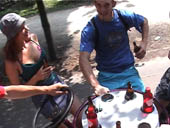Case Study 1
Conference Bike Safety


| Goal | To identify major safety issues with a bike for 7 people. |
| Deliverables |
Short-term: essential instructions with pictograms Long-term: changes to the physical design of the bike |
| Process | I began the process with a field study, where I videotaped a wide variety of people riding the bike. The video was used in a workshop with sales, manufacturing, and an external bicycle expert in order to prioritize safety issues and brainstorm solutions. |
Sample Results
Example 1
It is important for riders to hold on so they don't get thrown off if the bike stops suddenly. The manufacturer knew that many riders don't hold on, and the field study confirmed this. However, there were different reasons why people didn't hold on. Some thought it looked "cooler" to not hold on, but others were unable to hold on properly because they were holding cameras, plastic bags, purses, mobile phones, etc. Simply reminding these people to hold on would not help them to hold on, so this led to recommendations for more personal storage space on the bike.
The field study helped to develop a deeper understanding and
more appropriate response to people's behavior.
Example 2
The existing manual for the conference bike prohibits sandals or other types of loose footwear. The rationale is that people's feet may slip off the pedal and they would fall under the bike. However, in the video clips we saw people using all sorts of footwear (even bare feet) without incident. After some discussion, we realized that their was no danger with loose footwear as long as riders didn't stand up when they pedaled. If they remained seated, then any type of footwear was appropriate. This insight allowed us to replace an unnecessary rule ("No sandals") with a more crucial rule ("Remain seated while pedaling").
The workshop created a forum where we could discuss and better define
the key risks.
Related: Case Study 2: Manual of the Future
![Pronounced [Zin-site] Xinsight logo](/images/xinsight_reveal_dark.gif)





